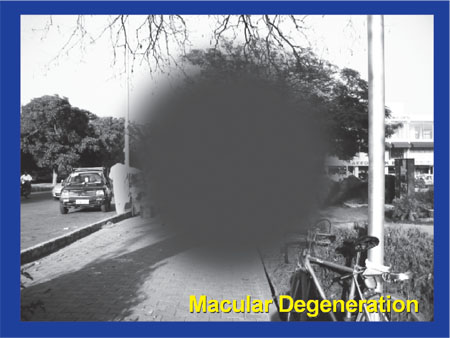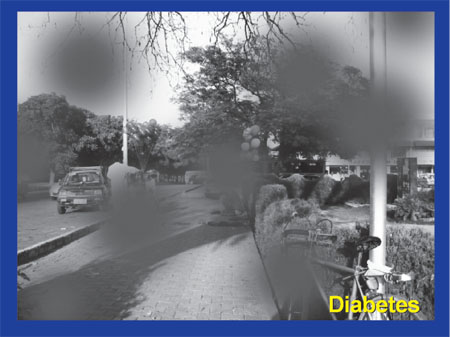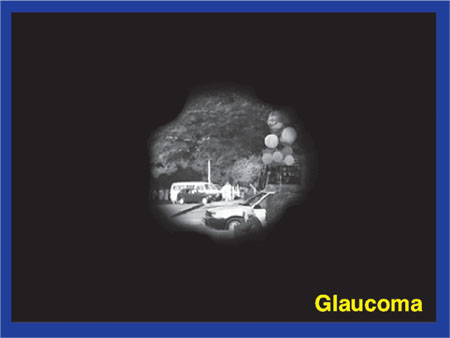Chapter 3
Managing the Patient With a Sensory Disability
Aim
The aim of this chapter is to increase awareness and understanding about the management of people with visual impairment, hearing impairment and the combination of both known as “deaf blindness”.
Outcome
After reading this chapter you should have an understanding of the common causes of visual and auditory impairments, the demography of these conditions and the most appropriate ways of communicating with people affected by these conditions.
Introduction
Communication is a complex system of sending, receiving, and interpreting messages that relies, to a great extent, on seeing, hearing or both. If either or both of these sensory systems are impaired, the communication process can be damaged. This can have a profound effect on access to dental services by complicating the appointment-making process. In the dental setting the ability to glean essential information during history taking, to build patient rapport and trust, and the provision of effective preventive information can be impaired. The communication process can become time-consuming and frustrating for all involved if it is not well managed.
Visual and auditory impairments may be congenital, inherited, or acquired throughout life as the result of accident, disease, or as part of the ageing process.
Visual Impairments
Visual impairment refers to those people who have a visual disability that cannot be corrected by spectacles. It includes people who are entitled to register as blind or partially sighted, have difficulty reading an ordinary-print newspaper, or whose sight restricts their mobility. Most visually impaired people have some useful residual sight and only 4% cannot distinguish between light and dark.
Partial sightedness refers to people who cannot clearly see how many fingers are being held up at a distance of 6 metres or less (even with their glasses or lenses).
Blindness occurs when a person is unable to clearly see how many fingers are being held up at a distance of 3 metres or less (even with their glasses or lenses). However, they may still have some degree of vision (Table 3-1).
| Visual acuity | Visual impairment |
| VA 6/12 to > 6/18 | Disruptive to lifestyle; may be unable to drive; difficulty reading small print and recognising a friend across the street, even when wearing glasses |
| VA 6/18 to better than 3/60 | Severe sight problem. Partially sighted and can only read the top letter of the eye chart from six metres or less |
| VA < 3/60 | Registered as blind and can only read the top letter of the eye chart from three metres or less |
Demography: In the UK it is estimated that there are:
-
About 1.7 million people over the age of 65 with sight problems. This represents 90% of all visually impaired people. Most of this group have lost their sight gradually, and many have an additional disability or illness.
-
Approximately 25,000 children have sight problems and about 12,000 of these children also have other disabilities.
-
378,000 people are registered as blind or partially sighted.
Aetiology: The symptoms of sight loss depend greatly on the cause and can be due to disease, nerve damage or accidents. Common causes of visual impairment are:
-
Macular degeneration: This accounts for about 50% of all registerable visual impairment and is the most common cause of poor sight in people over the age of 60. It usually involves both eyes, although they may not be affected at the same time. The macula, at the centre of the retina, which is used for detailed activities such as reading, recognising faces, and detecting colours is affected. In the early stages, central vision may be blurred or distorted, with objects looking an unusual size or shape and straight lines appearing wavy or fuzzy. This may happen quickly or develop over several months. There may be extreme sensitivity to light or the person may see lights, shapes and colours that are not there. As it becomes advanced, the individual will often notice a blank patch or dark spot in the centre of their sight. This makes reading, writing and recognising faces or small objects difficult. Age-related macular degeneration is not painful, and rarely leads to total blindness. People usually retain sufficient peripheral vision to be able to get around and maintain their independence (Fig 3-1).
-
Cataracts: These can form at any age, but most often develop as people get older. In younger people cataracts can result from conditions such as diabetes, certain medications and other long-standing eye problems. A cataract is one or more opacity of the crystalline lens. The opacification of the lens may occur in different ways, so that the light rays which reach the retina may be split, causing multiple images. Having cataracts has been likened to looking through a dirty windscreen – if the sun is behind you, your view is reasonably good, but if the sun is in front of you, then your view can be seriously impaired (Fig 3-2). Approximately 50% of people between 65 and 74 years of age and 70% of people over the age of 75 have cataracts.

Fig 3-1 Macular degeneration.

Fig 3-2 Cataract.
They can experience:
-
decreased visual acuity
-
decreased contrast sensitivity leading to difficulty seeing in poorly lit environments
-
increased sensitivity to light and glare
-
blurred distance vision
-
difficulty reading
-
difficulty with colour contrast
-
double vision.
Cataract surgery has a high success rate and 95% of patients experience improved vision if there are no other eye conditions present.
-
Diabetic retinopathy: This is the largest single cause of registerable visual impairment among people of working age. The probability of a visual impairment is greatly increased if the diabetes is poorly controlled. In diabetic retinopathy the fine network of fragile blood vessels in the retina may leak or become blocked, causing local loss of function. At first, there will be a few specks of blood, or spots, “floating” in the field of vision (Fig 3-3). Bleeding can reoccur and cause severely blurred vision. It can cause double vision and difficulty focusing. If left untreated, proliferative retinopathy can cause severe vision loss and even blindness. Other side-effects of diabetes include poor circulation and peripheral neuropathy; these can result in poor tactual sensitivity which means that people with diabetes may not be able to read Braille.
-
Glaucoma: There are several types of glaucoma. Congenital glaucoma appears in young people, primary glaucoma is most frequently associated with ageing, and secondary glaucoma is the result of injury or trauma. It is uncommon below the age of 40 but affects 1% of people over the age of 40 years and 5% of people over the age of 65. People over the age of 60, of African origin and over the age of 40, and people with a family history of glaucoma are at risk of developing glaucoma. It impairs vision by creating pressure that damages the optic nerve. The first problems are with peripheral vision. As it progresses, it can destroy all peripheral vision causing tunnel vision, and eventually impairing central vision leading to total blindness (Fig 3-4).
Treatments for glaucoma are aimed at bringing down the pressure in the eye to a level that is low enough to prevent harm to the optic nerve. Once the optic nerve is damaged, lowering the pressure only prevents further damage. With tunnel vision, it is often possible to read small print, but not large print.

Fig 3-3 Diabetic retinopathy.

Fig 3-4 Glaucoma – tunnel vision.
Recognition: People with a visual impairment may be recognisable because they have difficulty reading, wear specialised glasses, carry a white cane or stick, and/or are acc/>
Stay updated, free dental videos. Join our Telegram channel

VIDEdental - Online dental courses


